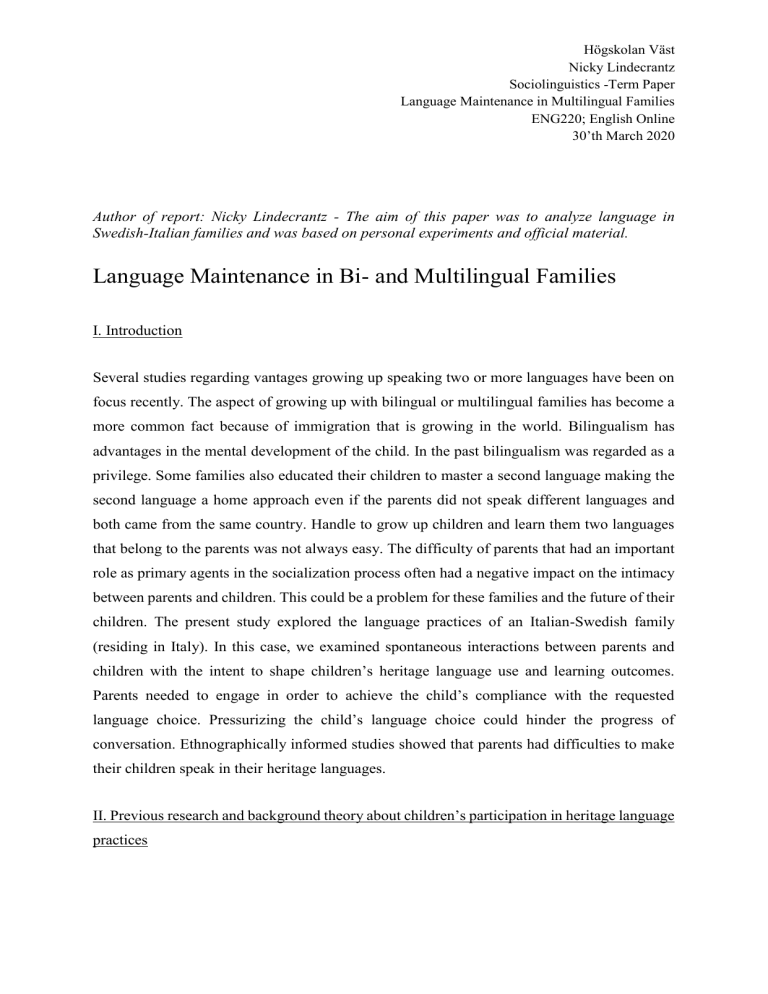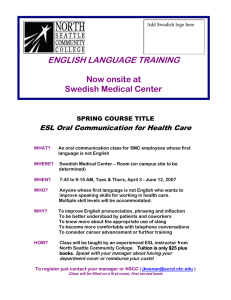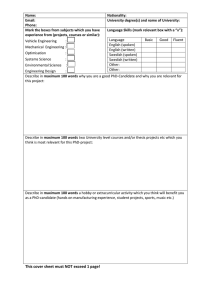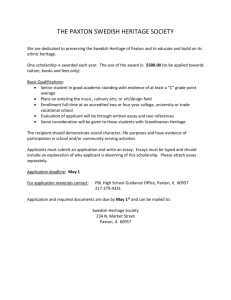Language Maintenance in Bi- and Multilingual Families - by Nicky Lindecrantz
advertisement

Högskolan Väst Nicky Lindecrantz Sociolinguistics -Term Paper Language Maintenance in Multilingual Families ENG220; English Online 30’th March 2020 Author of report: Nicky Lindecrantz - The aim of this paper was to analyze language in Swedish-Italian families and was based on personal experiments and official material. Language Maintenance in Bi- and Multilingual Families I. Introduction Several studies regarding vantages growing up speaking two or more languages have been on focus recently. The aspect of growing up with bilingual or multilingual families has become a more common fact because of immigration that is growing in the world. Bilingualism has advantages in the mental development of the child. In the past bilingualism was regarded as a privilege. Some families also educated their children to master a second language making the second language a home approach even if the parents did not speak different languages and both came from the same country. Handle to grow up children and learn them two languages that belong to the parents was not always easy. The difficulty of parents that had an important role as primary agents in the socialization process often had a negative impact on the intimacy between parents and children. This could be a problem for these families and the future of their children. The present study explored the language practices of an Italian-Swedish family (residing in Italy). In this case, we examined spontaneous interactions between parents and children with the intent to shape children’s heritage language use and learning outcomes. Parents needed to engage in order to achieve the child’s compliance with the requested language choice. Pressurizing the child’s language choice could hinder the progress of conversation. Ethnographically informed studies showed that parents had difficulties to make their children speak in their heritage languages. II. Previous research and background theory about children’s participation in heritage language practices Högskolan Väst Nicky Lindecrantz Sociolinguistics -Term Paper Language Maintenance in Multilingual Families ENG220; English Online 30’th March 2020 To Garafanga and Luykx influence and shaping parental language behavior contributed to language maintenance or language shift. Children replaced a language to another or refused the heritage language of their parents.1 Garafangas study demonstrated that children-initiated negotiations about language choice for the interaction with their parents. The only way to resolve the problem was to adopt the child’s selected code and to establish the majority language for the main use of conversation.2 According to Mina Kheirkhah, younger children could more easily accept their parents’ requests to use a specific language, while older children showed more powerful resistance. Children’s language practices and choices could change and therefore this fact could be a relevant issue for further study.3 You can find many reports and studies about bilingualism online. My research was based on reports from Mina Kheirkhah, Sara Moda, Joseph Garafanga, Luykx, Aurolyn, Lorena Galliot, and Adam Beck. III. Theory Theories were different and the methods used differed. Family expectations were different when it came to be bilingual. Having the ability to understand a second language would be enough for some families, while other parents expected their children to communicate in both languages as well. Language ability is evaluated in terms of listening, speaking, reading and writing. To provide a good balance in your children’s bilingual ability it could be important to be dedicated from the start. Studies showed that it was easier to learn two languages from birth. And even during pregnancy, it could be useful to talk with the child in both languages. Once children start attending school in one primary language, it gets more difficult to maintain balance with the minority language. When families discussed their goals for language development, they often saw their children acquire higher levels of language skills in both languages. Being passionate and realistic with their goals meant not leaving anything up to chance. Parents needed to talk about how to bring bilingualism to a successful conclusion. According to Fred Genesee, a professor of psycholinguistics at McGill University in Montreal, 1 (Garafanga 2010; Luykx 2005) (Garafanga 2010) 3 (Kheirkhah 2016, p. 24) 2 Högskolan Väst Nicky Lindecrantz Sociolinguistics -Term Paper Language Maintenance in Multilingual Families ENG220; English Online 30’th March 2020 the children should be exposed to at least 30% of their second language. Less exposure resulted in the children understanding but they may not speak their second language. Exposing them to their second language more of the time is the best choice.4 IV. Methods Several studies have pointed to the importance of children’s age for their language use, there has been little discussion of how children’s age figures in as a feature that can impact on children’s and families’ language practices.5 There are different methods for maintaining a bilingual home. 1. One parent - one language: The mother always speaks her own language with the children, and the father always speaks his own language with them. 2. One - place - one - language, meaning one language is spoken at home while the other is spoken at daycare, school, camp, etc. Mixing languages in the same conversation would make it harder for children to separate vocabulary and grammar into the appropriate language. This could cause them to learn a sort of hybrid language with little sense to anyone but them. While raising bilingual children, it was common for them to mix up languages. Maybe they were used to cooking with the parent who spoke Italian, so they always used Italian food words when they spoke the other language. If children did only hear the ‘less important’ language from one parent, they could maybe not get enough exposure for that language to develop it naturally. It could be important to find other ways of exposing them to a second language like books or songs, films, and games. It would be great to find a babysitter who speaks the other language to look after your children occasionally. It helps tremendously for your children to hear that their parent isn’t the only one who speaks this language. As your children grow up, they still need to practice, especially the minority language. If your children like to write, you might suggest they write with their cousins and friends in your home country. Writing letters, emails or WhatsApp's to another child in a foreign country not only improves your children’s writing skills but teaches them 4 5 (Lorena Galliot, NYT, 2007) (Kheirkhah, Mina, page 24) Högskolan Väst Nicky Lindecrantz Sociolinguistics -Term Paper Language Maintenance in Multilingual Families ENG220; English Online 30’th March 2020 how to build a relationship with someone from a different background than themselves. Children are more than capable of understanding that they don’t really need to know a language if the other person they interact with speaks it. Reading to your children in your native language is a wonderful way to help them become bilingual. This includes telling stories that you learned as a child. Talk about the pictures in books together and fantasies about alternative endings. Books and storytelling help children develop all the skills for linguistic knowledge. As your children begin to read on their own, make sure they have enough reading material. Let your family and friend send them books and magazines in their second language. Traveling to your home country is one of the most powerful ways to promote language development and cultural understanding. Being in an exciting new place where everyone speaks their second language, children can better learn that language. They can practice constantly with family and friends they meet, and they will associate the language with all those great memories years after the trip is over. It’s quite common for children to refuse to use one of the languages they are exposed to and parents get often very frustrated. However, this is very normal, and there’s no reason to worry about it. If you can understand what is blocking your child, you already are on the right way to resolving the problem.6 Maybe your child just doesn’t feel comfortable with the second language. Maybe your child is embarrassed because he/she doesn’t manage it well. Try to find out and to show your child that it is ok not to speak both languages. V. Example of children’s participation in heritage language practices The mother in the focus family was a native Swedish speaker from Sweden with a high level of knowledge of English and German. The father was a native Italian speaker. The mother immigrated to Italy at age 19. They spoke Italian fluently and had middle-class occupations. Their daughters, Sofia (10 years), and Federico (12 years) started attending Swedish educational settings early in life but the older son refused the Swedish language and the mother stopped speaking only Swedish to him and after with the daughter. Sofia managed Swedish 6 (Adam Beck, 2013 and Rita Rosenback, 2019) Högskolan Väst Nicky Lindecrantz Sociolinguistics -Term Paper Language Maintenance in Multilingual Families ENG220; English Online 30’th March 2020 better. She understood it and when she talked, she could be code-switching, but she made herself understandable. Her opening sequences were perfect and after she could switch to Italian. Federico understood Swedish but the only way of speaking it was by borrowing some words sometimes. Their Swedish and English-speaking aunts and cousin from Sweden visited the family regularly. Parents and adult relatives are the children’s main heritage language contacts. The mother’s biggest concern was the Politeness of her kids. Therefore, she had introduced them to appropriate behavior while speaking Swedish and English. Example 1: Sofia: Good morning grandfather. How are you? (Code-switching to Italian) Noi stiamo bene qui. (code-switching to Swedish) Hej. The Swedish mother has insisted on learning Swedish dishes and words to the children anyway and they understand some Swedish but don’t speak correctly. Films and books were read in Swedish and even the prayer in the evening was performed in Swedish as the evening lullaby. Starting school, the main interest was speaking correctly English. Speaking English, the children were able to communicate with the Swedish family of the mother. Federico handles English better, feeling more comfortable speaking it and he speaks English with his family in Sweden, borrowing some Swedish word sometimes. Example 2: Federico: Good Morning nonno (borrowing), how are you? I’m fine and I am going to swimming lessons in the afternoon. That’s great. (borrowing) Hej då. See you soon. Results of the children’s behavior. Sofia (Example 1) used more code/switching, she wanted to speak all three languages and tried to do so. While Federico (Example 2) was shy and felt uncomfortable speaking Swedish. Meanwhile, English that he studied at school made him feel better and he just borrowed some words to show his Swedish engagement. It was useful to be careless about social customs. Example 3: Högskolan Väst Nicky Lindecrantz Sociolinguistics -Term Paper Language Maintenance in Multilingual Families ENG220; English Online 30’th March 2020 Quotation from an American woman living in Italy, Peggy Peden: "I sometimes switch to English when I’m talking to my sons, but for the most part, I try to stick with Italian unless it’s something that I want everyone around us to understand. I’m the only English-speaker in their lives so it’s important for me to be consistent. Yes, it does feel a bit rude sometimes, but mostly we’re with people who know us well. A lot of Italian parents love it. They like their kids to come to our house because they get to practice their English." VI. Results The focus of the present study is on what has been identified as the recurrent explicit (language management) practices through which the parents negotiated and, at times, attempted to enforce the parent-child heritage language policy. When the children inserted a Swedish lexical item into an utterance in Italian or in Swedish, the parents usually oriented to this as a deviation from the language norms. They asked the children to translate the problematic item into the relevant heritage language, or otherwise explicitly corrected the child by providing relevant information about the heritage language. The parents said that they did not wish to ostracize the children with too many instructions or to enforce their language policy, but that they preferred to offer corrections and instructions even in cases of child resistance. The primary target of these practices was the younger son, Federico, who, according to the parents, was less competent in heritage languages than his younger sister. VII. Concluding discussion This report explored how family language policies are used in parent-child interactions and did reveal different interactions of children from the same family background. Children actively performed language shifts or resisting to use the adults’ heritage language. The parents used different methods to include the mother-language with different results. In the end the parents decided for a monolingual interaction with the children and adopted the heritage language as a second language as the ones studied at school.7 Meanwhile the children grew older the socialization with other languages including the heritage language became easier because of 7 (Garafanga 2010, p. 251) Högskolan Väst Nicky Lindecrantz Sociolinguistics -Term Paper Language Maintenance in Multilingual Families ENG220; English Online 30’th March 2020 interaction of social life. Forcing the child to use the heritage language became a threat and it was more indicated to use learning as a second priority to not stress the child and include only some few interactions like food, songs and reading. The child that was more engaged in the heritage language wanted to learn the heritage language voluntarily. This was done by reading heritage language books, watching heritage language films and singing songs and speaking prayers. The linguistic phenomena from this multimodal behavior and mixing different language varieties revealed to be the most significant factor that shaped the family’s language policies. Today there has been developed a new case with children seen as active and social agents. Immigrated children can learn their parents the new language and invert the role of education. There is needed a research of language shift to recognize the role of children as interactional partners more than this case has been so far.8 Electronic References: • Rita Rosenback 2019 https://multilingualparenting.com/2016/05/04/multilingual-families-why-a-child-might-grow-upmonolingual/ •Adam Beck, My Best Tips for Raising Bilingual Kids, JANUARY 7, 2013 http://bilingualmonkeys.com/wpcontent/documents/My-Best-Tips-for-Raising-Bilingual-Kids.pdf •Kheirkhah, Mina & Cekaite, Asta. (2015). Language Maintenance in a Multilingual Family: Informal Heritage Language Lessons in Parent-Child Interactions. Multilingual. 34. 10.1515/multi-2014-1020. https://www.researchgate.net/publication/275226288_Language_Maintenance_in_a_Multilingual_Family_Informal_Heritag e_Language_Lessons_in_Parent-Child_Interactions •Mina Kheirkhah, 2016 Department of Thematic Studies – Child Studies Cover page photo is taken by Ghazaleh Rajabzadeh Printed in Sweden by LiU-Tryck, Linköping, Sweden, 2016 https://www.divaportal.org/smash/get/diva2:912713/FULLTEXT01.pdf •Luykx, Aurolyn. 2005. Children as socializing agents: Family language policy in situations of language shift. Proceedings of the 4th International Symposium on Bilingualism (ISB), 1407-1414. http://www.lingref.com/isb/4/111ISB4.PDF •Analysis of two strategies for Italian parents raising bilingual children in Italy, Sara Moda n° matr.1063280 / LMLCC 2014/2015 http://tesi.cab.unipd.it/49189/1/SARA_MODA_2015.pdf •Gafaranga, Josef. 2010. Medium request: Talking language shift into being. Language in Society, 32 (2). 241-270. https://www.research.ed.ac.uk/portal/files/12594846/GAFARANGA_J_Medium_request_Talking_language_shift_into_bein g.pdf 8 (Luykx, Aurolyn. 2005 and Garafanga 2010, p.245) Högskolan Väst Nicky Lindecrantz Sociolinguistics -Term Paper Language Maintenance in Multilingual Families ENG220; English Online 30’th March 2020 •Language acquisition is a matter of exposure by Lorena Galliot, New York Times https://www.nytimes.com/2007/04/26/style/26iht-alang.1.5454742.html




